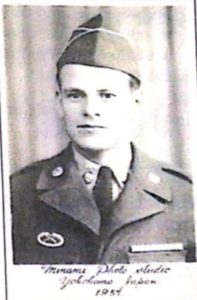
Antonio Parra
ANTONIO PARRA BERNAL BIOGRAPHY
Antonio Parra Bernal, born in Garagoa on September 25th, 1925, son of Juan Parra and Dolores Bernal, was chosen for the Colombia Battalion that represented the country in the international war in Korea. In 1942 he was doing his military service at the artillery school in Bogotá. In 1943 he came out with the rank of corporal second. After a short stay with his family, he entered the Cundinamarca guard where he spent three years. In 1948 he joined the military police. He set out to improve himself intellectually, sometimes surpassing his fellow high school graduates. Because of his excellent qualities in military discipline, a captain, a member of the Academy of History, told his group that he would be leaving for the Korean War and that he would like his team will accompany you. Antonio volunteered for it.
After a three-month training in Bogotá, he left to Korea in May 1951, in the midst of 1,035 men who made up the squad.
In Korea he acted as commander in a squad of 9 men that made up a platoon of 36 soldiers, he participated in all the combats in which the Colombia Battalion intervened. Corporal Antonio Parra, due to its recognized value, was always sent to the outposts, that is, the most dangerous. Of the actions that were remembered the most, there is the taking of the Chamizo and the combat of the Kumsong Valley. In the latter, once taken and occupied by the Colombians, after a few weeks they were attacked by the Chinese at midnight, with the consequent death of almost the entire company of 136 men,wounded officer and they took him to a saved by Corporal Antonio Parra, he is the secretary of the Association of Veterans of the International War of Korea and his name is Rómulo Olaya.
Antonio Parra Bernal, nacido en Garagoa el 25 de Septiembre de 1925, hijo de Juan Parra y Dolores Bernal, fue escogido para el Batallón Colombia que representó al país en la guerra internacional de Corea. En 1942 prestaba su servicio militar en la escuela de artillería en Bogotá. En el año de 1943 salió con el grado de cabo segundo. Tras una corta estadía con su familia, ingresó a la guardia de Cundinamarca donde estuvo tres años. En el año de 1948 ingresó a la policía militar. Se propuso superarse intelectualmente, a veces aventajando a sus compañeros bachilleres.Por sus excelentes cualidades en la disciplina militar, un capitán miembro de la Academia de Historia, le comunicó a su grupo que se iría para la guerra de Corea y que le gustaría que su equipo lo acompañara. Antonio se ofreció para ello.
Tras un entrenamiento de tres meses en Bogotá, partió para Corea en Mayo de 1951, en medio de 1.035 hombres que conformaron el escuadrón.
En Corea actuó como comandante en una escuadra de 9 hombres que integraban un pelotón de 36 soldados, participó en todos los combates en los que intervino el Batallón Colombia. El Cabo Antonio Parra por su valor reconocido, era enviado siempre a los puntos de avanzada, es decir, los más peligrosos. De las acciones que más se acordaba, está la de la toma del Chamizo y el combate del Valle de Kumsong. En este último, una vez tomado y ocupado por los colombianos, después de unas semanas fueron contra atacados por los chinos a la media noche, con la consiguiente mortandad de casi toda la compañía de 136 hombres.Sólo unos compañeros se echaron al hombro a un oficial herido y lo llevaron hasta un salvado por el cabo Antonio Parra, es el secretario de la Asociación de Veteranos de la Guerra Internacional de Corea y se llama Rómulo Olaya.
Korean War - Key Events
April 11, 1951
U.S. Pres. Harry S. Truman relieves MacArthur of command for insubordination and his unwillingness to prosecute a limited war. He is succeeded as UN commander by Lieut. Gen. Matthew Ridgway.
These events are taken from the Encyclopedia Britannica

Comments
Likes 1
You must be a registered user to comment or like - please register to join us!